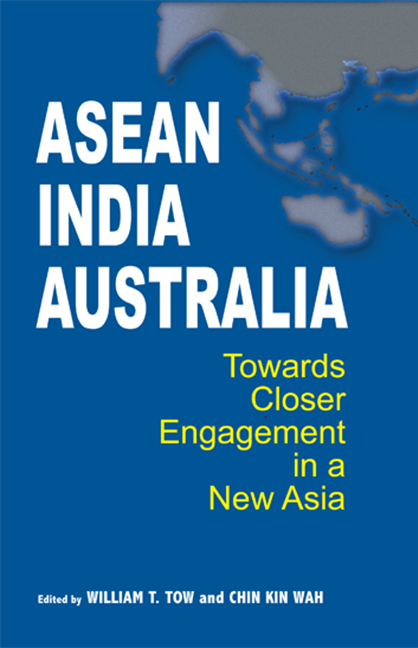Book contents
- Frontmatter
- Contents
- Preface
- Contributors
- List of Abbreviations
- Introduction
- Part I Emerging Regional Security
- 1 Emerging Regional Security Architecture: An Australian Perspective
- 2 Emerging East Asian Regional Architecture: ASEAN Perspectives
- 3 India in the Emerging Asian Architecture: Prospects for Security Cooperation with ASEAN and Australia
- 4 ASEAN, Australia, and India in Asia's Regional Order
- Part II Energy Security
- Part III Climate Change
- Part IV Maritime Security
- Part V Law Enforcement/Combating International Crime
- Conclusion
- Bibliography
- Index
1 - Emerging Regional Security Architecture: An Australian Perspective
from Part I - Emerging Regional Security
Published online by Cambridge University Press: 21 October 2015
- Frontmatter
- Contents
- Preface
- Contributors
- List of Abbreviations
- Introduction
- Part I Emerging Regional Security
- 1 Emerging Regional Security Architecture: An Australian Perspective
- 2 Emerging East Asian Regional Architecture: ASEAN Perspectives
- 3 India in the Emerging Asian Architecture: Prospects for Security Cooperation with ASEAN and Australia
- 4 ASEAN, Australia, and India in Asia's Regional Order
- Part II Energy Security
- Part III Climate Change
- Part IV Maritime Security
- Part V Law Enforcement/Combating International Crime
- Conclusion
- Bibliography
- Index
Summary
“Architecture” has become the latest buzzword in Asian security politics. The staggering growth in regional multilateralism which began during the 1990s has given rise to a burgeoning scholarship employing this terminology. Policymakers too have embraced the architectural metaphor. Yet despite this ubiquitous usage, little effort seems to have been expended to define explicitly what “security architecture” actually means. As a consequence, various scholars and practitioners of Asian security have ended up employing one and the same descriptor, but often with reference to quite different forms, dimensions, and configurations of cooperative activity.
This chapter seeks to redress that shortcoming. It begins by reviewing the ways in which various scholars have employed “security architecture” and by highlighting the contradictions that their often imprecise applications have created. It also examines the differing manner in which the region's incumbent “security architects” — the United States and the Association of Southeast Asian Nations (ASEAN) — have constructed and utilized the term. The chapter then proposes a definition of “security architecture” that is sufficiently ecumenical to appeal to scholars and practitioners alike, while at the same time rigorous and nuanced enough to exhibit genuine conceptual substance and regional specificity. A concluding section discusses the benefits of employing this new definition. It is proposed that this new definition will contribute to the advancement of knowledge by allowing scholars to communicate more effectively with one another; that it will help to bridge the gap between the so-called academic and policy worlds by facilitating meaningful dialogue between them; and, most importantly, that it will assist in establishing clear criteria for ascertaining what “security architecture” actually exists in the Asian region.
Scholarly Applications
The term “security architecture” grew in popularity during the early 1990s, largely as a result of the Cold War's termination. The demise of the Soviet Union transformed global strategic politics, giving rise to the establishment of indigenous order-building initiatives in those two theatres which had been so central in the superpower stalemate — Europe and the Asia-Pacific. Perhaps due to the historical legacy of America's role as what Hanns Maull terms the “master builder” of Western European security following the Second World War, the logic and applicability of the term “architecture” to post-Cold War Europe was apparent.
- Type
- Chapter
- Information
- ASEAN-India-AustraliaTowards Closer Engagement in a New Asia, pp. 3 - 21Publisher: ISEAS–Yusof Ishak InstitutePrint publication year: 2009



